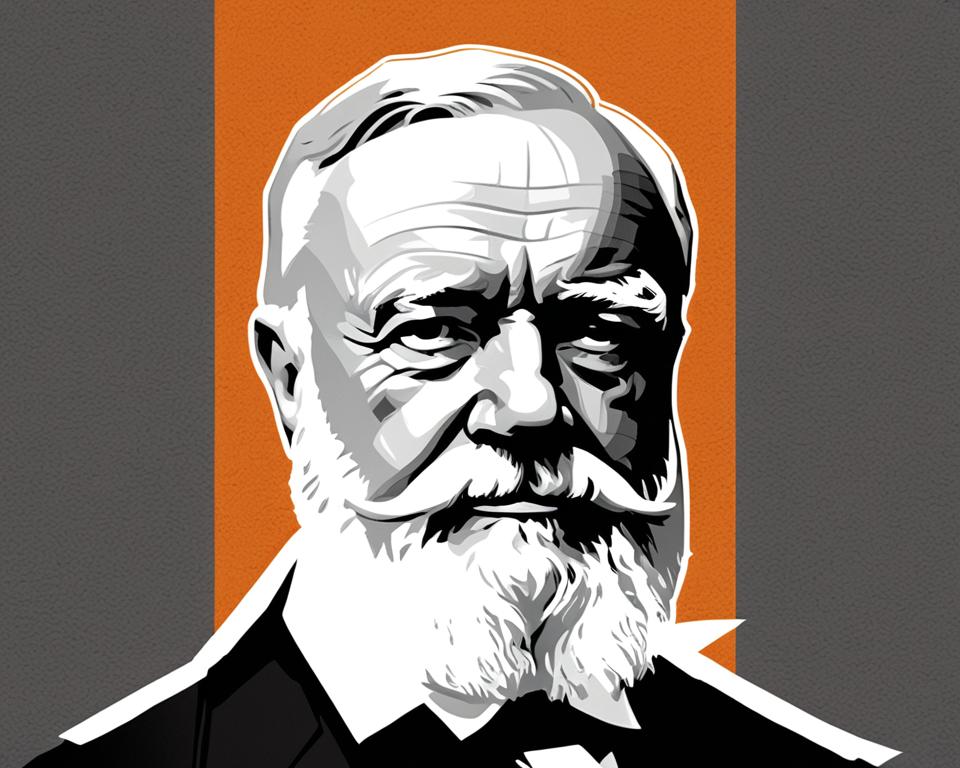Andrew Carnegie, a Scottish-American industrialist and philanthropist, was a remarkable leader known for his visionary thinking, innovation, and commitment to learning. His leadership style can serve as a valuable guide for modern leaders seeking business success and effective leadership qualities.
With a keen focus on giving back to society, Andrew Carnegie not only built a vast steel empire in the late 19th century but also left a lasting legacy through his philanthropy. In this article, we will explore the key principles of Andrew Carnegie’s leadership style and how they can inspire leaders to make a positive impact on the world.
Key Takeaways:
- Andrew Carnegie’s leadership style emphasized visionary thinking and innovation.
- Carnegie believed in the power of lifelong learning and constantly seeking new knowledge and skills.
- Philanthropy was a core principle of Carnegie’s leadership style, highlighting the importance of giving back to society.
- His success in both business and philanthropy continues to inspire leaders to achieve greatness.
- Carnegie’s legacy serves as a reminder to create a culture of innovation, lifelong learning, and social responsibility.
Table of Contents
Who Was Andrew Carnegie?
Andrew Carnegie, born in Scotland in 1835, was a renowned industrialist and philanthropist who left a lasting impact on the steel industry and business success. At the age of 13, Carnegie immigrated to the United States with his family, where he embarked on a remarkable journey that would shape his legacy.
Starting as a telegraph operator, Carnegie’s entrepreneurial spirit led him to invest in the steel industry. Through innovative business practices, he transformed the steel production process and established a global steel empire. His contributions to the industry revolutionized construction, transportation, and infrastructure, playing a crucial role in the growth and development of the United States.
While his success in the steel industry is impressive, Carnegie’s philanthropic efforts also define his legacy. Throughout his life, he dedicated a significant portion of his wealth to improving the lives of others. Carnegie believed in the importance of giving back to society, and his philanthropic endeavors extended to various areas, including education, libraries, and cultural institutions. His contributions continue to impact communities worldwide.
Andrew Carnegie’s remarkable journey from a telegraph operator to a prominent industrialist and philanthropist serves as an inspiration to aspiring entrepreneurs and leaders. His achievements in the steel industry, combined with his commitment to making a positive difference in the world, make him one of the most influential figures in history.
Key Highlights of Andrew Carnegie’s Life:
- Pioneer of the steel industry
- Innovative business practices
- Global steel empire
- Extraordinary philanthropic efforts
| Birthdate | Nationality | Career Highlights | Philanthropic Contributions |
|---|---|---|---|
| 1835 | Scottish-American | Pioneered steel industry | Funded libraries, education, and cultural institutions |
Leadership Lessons from Andrew Carnegie
Andrew Carnegie’s leadership style was characterized by several key principles. He believed that leaders should have a strong vision and a drive for innovation. Carnegie constantly looked for new ways to improve his business and make a positive impact on the world. As a pioneer of the steel industry, he used new technologies and innovative business practices to build a vast empire and revolutionize the industry.
Carnegie also emphasized the importance of commitment to learning. He believed that leaders should constantly seek new knowledge and skills, staying curious and adaptable in an ever-changing world. This commitment to lifelong learning enabled Carnegie to stay ahead of his competitors and continue growing his business.
Furthermore, Carnegie had a deep belief in the power of philanthropy. He understood the need for leaders to give back to society and make a difference in the lives of others. Through his philanthropic efforts, Carnegie funded the construction of public libraries, established research institutions, and supported educational and cultural organizations.
These leadership lessons from Andrew Carnegie serve as a guide for modern leaders, inspiring them to achieve business success while making a positive impact on the world. By embracing visionary thinking and embracing innovation, leaders can drive their organizations forward. They can also prioritize commitment to learning, constantly seeking growth and development. Finally, through philanthropy, leaders can contribute to the betterment of society, creating a more equitable and sustainable future for all.
Key Leadership Lessons from Andrew Carnegie:
- Vision and Innovation: Leaders should have a clear vision and constantly seek innovative solutions to drive their organizations forward.
- Commitment to Learning: Lifelong learning and curiosity are essential for leaders to adapt to changing environments and stay ahead.
- Philanthropy: Leaders have a responsibility to give back to society and make a positive impact on the world.
| Leadership Lessons | Description |
|---|---|
| Vision and Innovation | Leaders should have a clear vision for their organizations and constantly seek innovative solutions to drive growth and success. |
| Commitment to Learning | Leaders should prioritize ongoing learning and development to adapt to changing circumstances and stay ahead of their competitors. |
| Philanthropy | Leaders have a responsibility to give back to society and make a positive impact on the world through philanthropic efforts. |
The Legacy of Andrew Carnegie
Andrew Carnegie’s leadership legacy is still felt today. He built the Carnegie Steel Company, which dominated the global steel market and revolutionized the industry. The company’s innovative practices and efficient production methods allowed Carnegie to amass enormous wealth and cement his status as one of the most influential leaders in history.
But Carnegie’s impact went beyond business success. He was also known for his philanthropic endeavors, using his vast wealth to improve the lives of others. One of his most notable philanthropic projects was the funding of public libraries. Carnegie believed that access to knowledge was essential for personal and societal development, so he donated money to build thousands of libraries across the United States and around the world.
In addition to libraries, Carnegie established research institutions, educational facilities, and cultural organizations. His commitment to giving back to society inspired many influential leaders who followed in his footsteps, realizing the power of philanthropy in making a positive impact on the world.
The Influence of Carnegie’s Philanthropy
Carnegie’s philanthropic efforts have left a lasting mark on society. Through his generous donations, he helped shape the educational landscape and fostered a culture of lifelong learning. The libraries he funded became community centers, providing access to books, resources, and opportunities for personal and intellectual growth.
The legacy of Carnegie’s philanthropy extends beyond the physical structures. It has inspired countless individuals to pursue their passions, dedicate themselves to education, and contribute to the betterment of society. The ripple effect of his philanthropic initiatives can still be seen today, with influential leaders continuing his tradition of giving back and making a difference.
| Philanthropic Endeavors | Impact |
|---|---|
| Funding public libraries | Provided access to knowledge and learning opportunities for millions |
| Establishing research institutions | Advanced scientific and technological advancements |
| Supporting educational facilities | Enabled the development of future leaders and innovators |
| Sponsoring cultural organizations | Enriched communities through arts and cultural experiences |
Carnegie’s leadership legacy, marked by business success and remarkable philanthropy, continues to inspire leaders today. His dedication to making a positive impact on the world illustrates the importance of leveraging wealth and influence to uplift others. By emulating Carnegie’s leadership style and embracing his commitment to philanthropy, leaders can leave a lasting legacy and shape a better future for generations to come.
Conclusion
Andrew Carnegie’s leadership style embodies the fundamental principles that can drive both business success and positive societal impact. With his visionary thinking, innovative approach, commitment to learning, and strong philanthropic values, Carnegie sets an example for modern leaders to follow.
By embracing Carnegie’s leadership lessons, leaders can create a culture of innovation within their organizations. The ability to think big, explore new ideas, and embrace change is key to staying ahead of the competition and achieving long-term success.
Carnegie’s emphasis on lifelong learning is another crucial aspect of his leadership style. Continuously seeking knowledge, developing new skills, and fostering a growth mindset not only benefits individual leaders but also contributes to the overall growth and success of the business.
Furthermore, Carnegie’s dedication to philanthropy reminds leaders of their responsibility to give back to society. By incorporating social responsibility into their business strategies, leaders can make a positive impact, improve communities, and create a legacy that extends beyond financial success.


